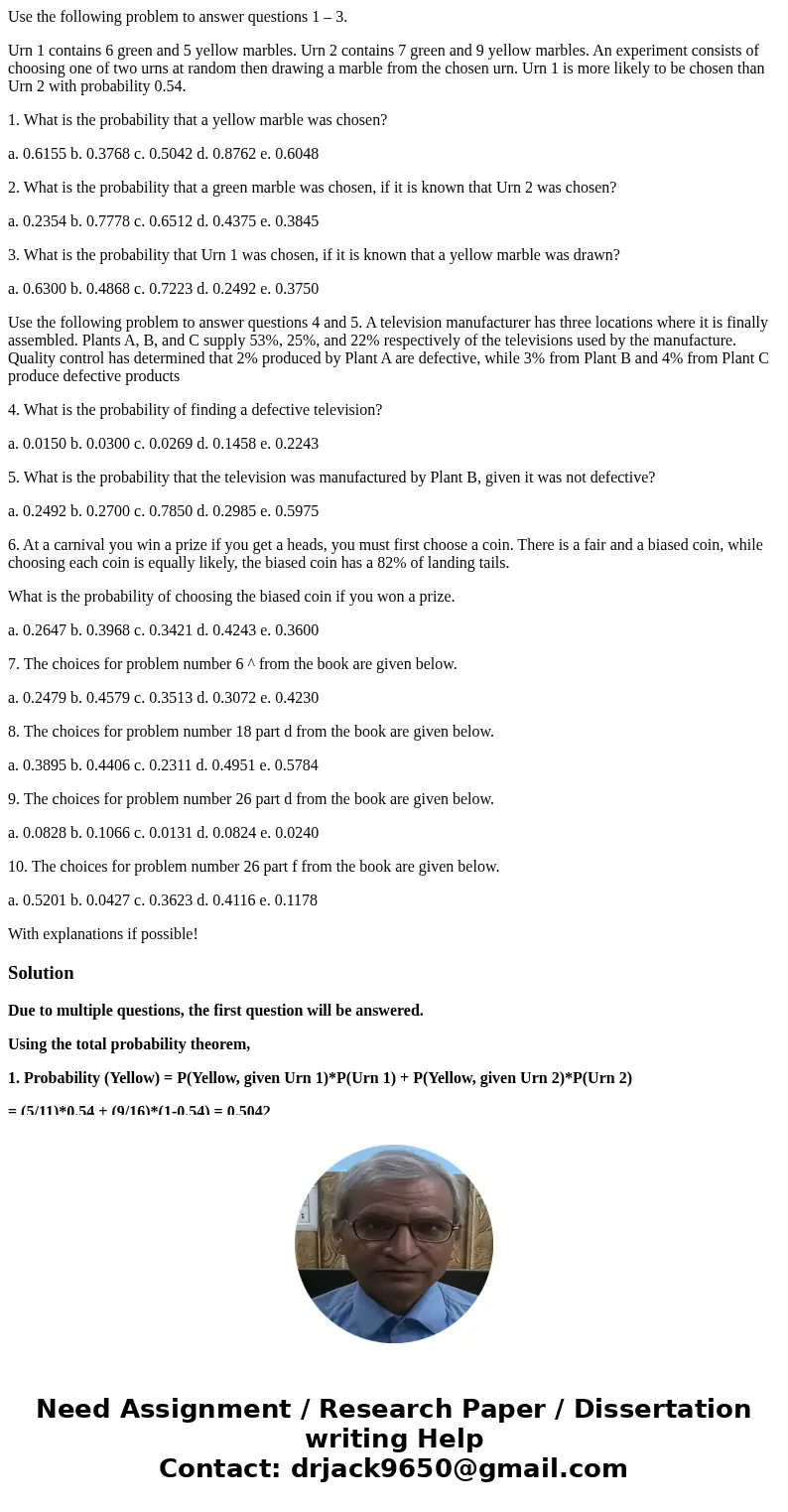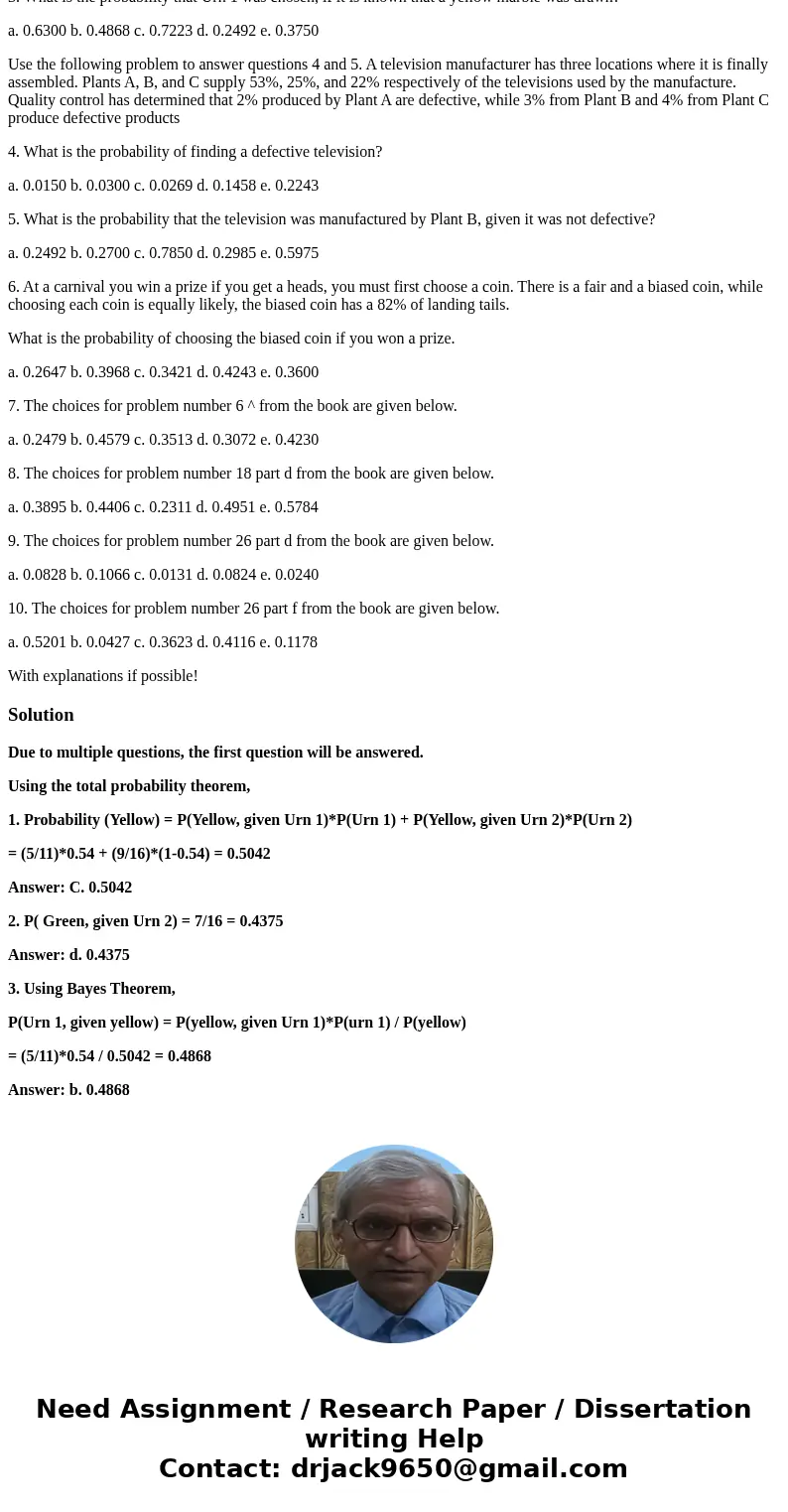Use the following problem to answer questions 1 3 Urn 1 con
Use the following problem to answer questions 1 – 3.
Urn 1 contains 6 green and 5 yellow marbles. Urn 2 contains 7 green and 9 yellow marbles. An experiment consists of choosing one of two urns at random then drawing a marble from the chosen urn. Urn 1 is more likely to be chosen than Urn 2 with probability 0.54.
1. What is the probability that a yellow marble was chosen?
a. 0.6155 b. 0.3768 c. 0.5042 d. 0.8762 e. 0.6048
2. What is the probability that a green marble was chosen, if it is known that Urn 2 was chosen?
a. 0.2354 b. 0.7778 c. 0.6512 d. 0.4375 e. 0.3845
3. What is the probability that Urn 1 was chosen, if it is known that a yellow marble was drawn?
a. 0.6300 b. 0.4868 c. 0.7223 d. 0.2492 e. 0.3750
Use the following problem to answer questions 4 and 5. A television manufacturer has three locations where it is finally assembled. Plants A, B, and C supply 53%, 25%, and 22% respectively of the televisions used by the manufacture. Quality control has determined that 2% produced by Plant A are defective, while 3% from Plant B and 4% from Plant C produce defective products
4. What is the probability of finding a defective television?
a. 0.0150 b. 0.0300 c. 0.0269 d. 0.1458 e. 0.2243
5. What is the probability that the television was manufactured by Plant B, given it was not defective?
a. 0.2492 b. 0.2700 c. 0.7850 d. 0.2985 e. 0.5975
6. At a carnival you win a prize if you get a heads, you must first choose a coin. There is a fair and a biased coin, while choosing each coin is equally likely, the biased coin has a 82% of landing tails.
What is the probability of choosing the biased coin if you won a prize.
a. 0.2647 b. 0.3968 c. 0.3421 d. 0.4243 e. 0.3600
7. The choices for problem number 6 ^ from the book are given below.
a. 0.2479 b. 0.4579 c. 0.3513 d. 0.3072 e. 0.4230
8. The choices for problem number 18 part d from the book are given below.
a. 0.3895 b. 0.4406 c. 0.2311 d. 0.4951 e. 0.5784
9. The choices for problem number 26 part d from the book are given below.
a. 0.0828 b. 0.1066 c. 0.0131 d. 0.0824 e. 0.0240
10. The choices for problem number 26 part f from the book are given below.
a. 0.5201 b. 0.0427 c. 0.3623 d. 0.4116 e. 0.1178
With explanations if possible!
Solution
Due to multiple questions, the first question will be answered.
Using the total probability theorem,
1. Probability (Yellow) = P(Yellow, given Urn 1)*P(Urn 1) + P(Yellow, given Urn 2)*P(Urn 2)
= (5/11)*0.54 + (9/16)*(1-0.54) = 0.5042
Answer: C. 0.5042
2. P( Green, given Urn 2) = 7/16 = 0.4375
Answer: d. 0.4375
3. Using Bayes Theorem,
P(Urn 1, given yellow) = P(yellow, given Urn 1)*P(urn 1) / P(yellow)
= (5/11)*0.54 / 0.5042 = 0.4868
Answer: b. 0.4868


 Homework Sourse
Homework Sourse